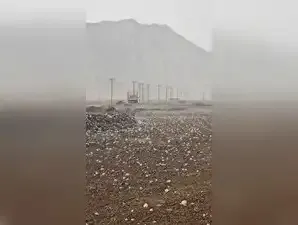Hail fell in parts of Al Ain on Saturday, June 28, in the afternoon, surprising residents during the UAE’s blazing summer. The National Centre of Meteorology (NCM) issued orange and yellow alerts on Saturday across parts of the Garden City, warning of unstable weather conditions, including heavy rainfall.
Social media users shared images and videos of hail falling over the villages of Khatm Al Shiklah and Malaqit. Temperatures in Sweihan, deep in the Al Ain desert, peaked at staggering 49.2°C. Meanwhile, Dubai and Abu Dhabi saw high humidity levels reach up to 60 percent.
Hail this afternoon in Al-Zorroub Mahada
The UAE has already experienced a record-breaking start to the summer, with temperatures hitting all-time highs in April and May. Yet, the hailstorm added a twist to the already extreme conditions.
Also Read: Did humans really live in the UAE 210,000 years ago? Cave discovery at Jebel Faya could rewrite human history
Though it may seem odd, summer hail in the UAE is not impossible, especially in regions like Al Ain, where altitude and weather instability can combine to produce unexpected conditions.
Hail forms when warm surface air rises rapidly into the atmosphere, pushing moisture high into much colder layers of air. There, the moisture freezes into pellets before falling back to earth.
While this is common in colder months, it can also happen during summer when temperatures on the ground and in the upper atmosphere vary dramatically.
Meteorologists explained that thermal instability is key to such phenomena. As the UAE’s hot desert air rises, it sometimes meets pockets of cooler air aloft, especially in mountainous or elevated regions like Al Ain. This can result in the formation of cumulonimbus clouds, known for producing hail.
Climate change and extreme weather in the UAE
Experts say extreme weather events are becoming more frequent in the Gulf due to climate change. Research suggests that the UAE is likely to see more volatile summer conditions, including heavier rain, more intense humidity, and sudden temperature swings
Social media users shared images and videos of hail falling over the villages of Khatm Al Shiklah and Malaqit. Temperatures in Sweihan, deep in the Al Ain desert, peaked at staggering 49.2°C. Meanwhile, Dubai and Abu Dhabi saw high humidity levels reach up to 60 percent.
Hail this afternoon in Al-Zorroub Mahada
The UAE has already experienced a record-breaking start to the summer, with temperatures hitting all-time highs in April and May. Yet, the hailstorm added a twist to the already extreme conditions.
Also Read: Did humans really live in the UAE 210,000 years ago? Cave discovery at Jebel Faya could rewrite human history
Why is it hailing in the UAE’s summer?
Though it may seem odd, summer hail in the UAE is not impossible, especially in regions like Al Ain, where altitude and weather instability can combine to produce unexpected conditions.
Hail forms when warm surface air rises rapidly into the atmosphere, pushing moisture high into much colder layers of air. There, the moisture freezes into pellets before falling back to earth.
While this is common in colder months, it can also happen during summer when temperatures on the ground and in the upper atmosphere vary dramatically.
Meteorologists explained that thermal instability is key to such phenomena. As the UAE’s hot desert air rises, it sometimes meets pockets of cooler air aloft, especially in mountainous or elevated regions like Al Ain. This can result in the formation of cumulonimbus clouds, known for producing hail.
Climate change and extreme weather in the UAE
Experts say extreme weather events are becoming more frequent in the Gulf due to climate change. Research suggests that the UAE is likely to see more volatile summer conditions, including heavier rain, more intense humidity, and sudden temperature swings





